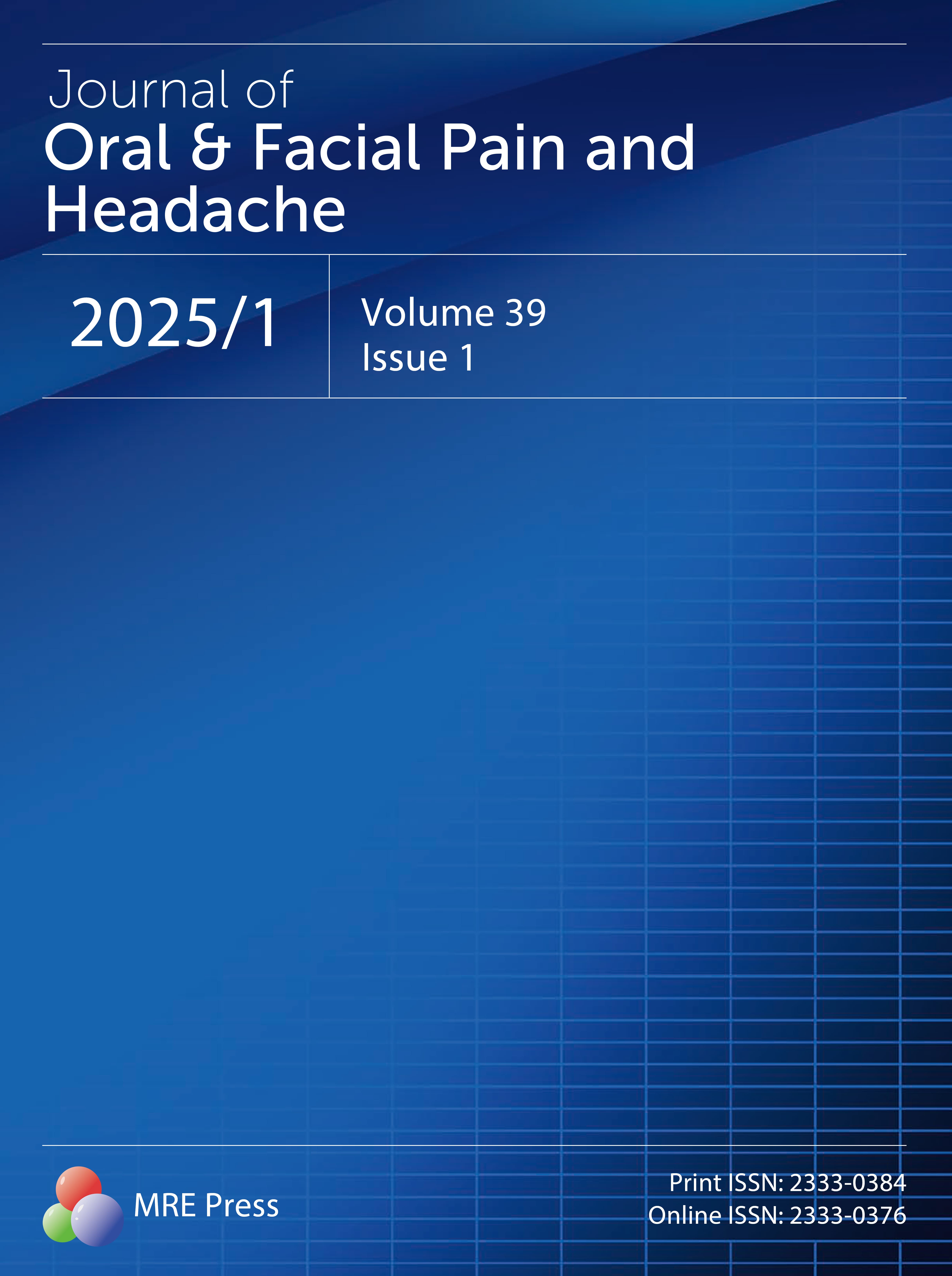Title
Author
DOI
Article Type
Special Issue
Volume
Issue
Article Menu
Export Article
More by Authors Links
Article Data
- Views 683
- Dowloads 62
Journal of Oral & Facial Pain and Headache (OFPH) is published by MRE Press from Volume 38 lssue 1 (2024). Previous articles were published by another publisher on a subscription basis, and they are hosted by MRE Press on www.jofph.com as a courtesy and upon agreement with Journal of Oral & Facial Pain and Headache.
Original Research
Open AccessTemporomandibular Disorders after Whiplash Injury: A Controlled, Prospective Study
Temporomandibular Disorders after Whiplash Injury: A Controlled, Prospective Study
1Department of Neurology, Aarhus University Hospital, Danish Pain Research Center, Aarhus University, Aarhus, Denmark
2Department of Orthodontics, Royal Dental College, Faculty of Health Sciences, Aarhus University, Orofacial Pain Laboratory, Aarhus, Denmark
3Department of Oral Physiology, Royal Dental College, Faculty of Health Sciences, Aarhus University, Orofacial Pain Laboratory, Aarhus, Denmark
4Center for Sensory-Motor Interaction, Aalborg University, Aalborg, Denmark
*Corresponding Author(s): Helge Kasch E-mail: helge.kasch@dadlnet.dk
Abstract
Aims: Whiplash injury to the neck is often considered a significant risk factor for development of temporomandibular disorders (TMD), and has been proposed to produce internal derangements of the temporomandibular joint (TMJ). Few studies, however, have examined TMD-related pain in acute whiplash patients compared with a matched control group. The aim of the present study was to assess pain and sensorimotor function in the craniofacial region in an unselected group of patients sustaining a motor vehicle accident involving a rear collision. Methods: Prospectively, 19 acute whiplash patients exposed to a motor vehicle accident involving a rear collision participated in a study of TMD. The control group consisted of 20 age- and gender-matched ankle-injury patients. Participants were seen within 4 weeks and again at 6 months post-injury. The masticatory system was examined in accordance with the research diagnostic criteria. Participants underwent structured interviews, filled out the McGill Pain Questionnaire (MPQ), and had their masticatory system examined by a trained dentist, blinded to their diagnosis. Pain detection threshold (PDT) to pressure stimuli, and maximal voluntary occlusal force (MVOF) were obtained at each visit. Results: One whiplash patient and 1 ankle-injury patient had jaw pain at the first visit. Palpation scores of the TMJ and the summated palpation scores only tended to be higher in patients sustaining a whiplash injury than in ankle-injury controls at the first visit. However, MPQ, TMD symptoms and signs, MVOF and PDT were not significantly different in whiplash-injury and ankle-injury patients after 4 weeks and 6 months. Conclusion: TMD pain after whiplash injury and ankle injury is rare, suggesting that whiplash injury is not a major risk factor for the development of TMD problems. Further studies are needed to identify which other factors may contribute to TMD pain.
Keywords
whiplash injuries; bite force; pressure algometry; craniofacial pain; TMD pain
Cite and Share
Helge Kasch, Tine Hjorth, Peter Svensson, Lone Nyhuus, Troels S. Jensen. Temporomandibular Disorders after Whiplash Injury: A Controlled, Prospective Study. Journal of Oral & Facial Pain and Headache. 2002. 16(2);118-128.
References

Abstracted / indexed in
Science Citation Index (SCI)
Science Citation Index Expanded (SCIE)
BIOSIS Previews
Scopus
Cumulative Index to Nursing and Allied Health Literature (CINAHL)
Submission Turnaround Time
Editorial review: 1 - 7 days
Peer review: 1 - 3 months
Publish Ahead of Print: within 2 months after being accepted
Notes: Your information is kept confidential throughout the review process.
Top
